Autores: Carlos Cevallos García1, José Verdejo Ortés1, María Teresa Ruano Martín1, María Ordobás Gavín1
1 Servicio de Epidemiología. Dirección General de Salud Pública. Consejería de Sanidad. Comunidad de Madrid.
RESUMEN
INTRODUCCIÓN
Desde la aparición de la infección por VIH y hasta la actualidad se han producido continuas variaciones en la epidemiología y morbimortalidad. Los avances terapéuticos están repercutiendo en las causas de muerte de los pacientes.
OBJETIVO
Como objetivo principal, conocer las causas de mortalidad en la población infectada por el VIH en la Comunidad de Madrid. Como objetivos secundarios conocer las causas en pacientes diagnosticados recientemente (período 2007-2014), y evaluar las causas de mortalidad precoz (MP) producida en los primeros cuatro años tras el diagnóstico y la cifra de linfocitos CD4+/µl en el momento del mismo, considerando dos subgrupos: meses 0 a 24 (MP1-24) y meses 25 a 48 (MP25-48). Todos los éxitus estudiados se han producido entre 2007 y 2014.
MÉTODOS
Fuente de datos: Registro de sida e infección por VIH de la Comunidad de Madrid. Se han consultado las historias clínicas electrónicas de los hospitales y de Atención Primaria y la mortalidad declarada por los Servicios Funerarios. Análisis estadísticos univariados y bivariados utilizando Chi cuadrado.
RESULTADOS
La mortalidad por eventos relacionados con el sida representó el 25,9% en el total de la muestra de pacientes. El porcentaje fue de 58% en pacientes con una evolución reciente de la infección (diagnosticados entre 2007 y 2014) (p<0.05). En los porcentajes de eventos sida las diferencias no fueron significativas entre (MP1-24) y (MP25-48). Sin embargo, la Presentación con Enfermedad Avanzada fue mayor en (MP1-24) (p<0.05). Los eventos no sida (ENOS) más frecuentes fueron los tumores y las hepatopatías.
CONCLUSIÓN
Los ENOS constituyen la principal causa de muerte en la población VIH positiva con independencia del año de infección, siendo los tumores y las hepatopatías las causas más frecuentes de éxitus. Sin embargo, en las infecciones recientes los eventos sida son más frecuentes, especialmente en la MP lo que podría estar relacionado con el recuento de linfocitos CD4+ al diagnóstico.
Palabras claves: VIH, mortalidad, retraso diagnóstico
CAUSES OF MORTALITY IN HUMAN IMMUNODEFICIENCY VIRUS -INFECTED POPULATION IN THE MADRID AUTONOMOUS REGION
(2007-2014)
SUMMARY
BACKGROUND
From the onset of the Human Immunodeficiency Virus (HIV) infection until now, there have been continuous variations in the epidemiology and its morbimortality rate. The therapeutic advances are having a repercussion on the causes of the death of patients
OBJECTIVE
Our main objective is to know the causes of death in the HIV-infected population in the Madrid Autonomous Region (MAR). As a secondary objective, we aim to find out the causes of the infection in patients who have had fewer years of evolution since diagnosis (diagnosed between 2007-2014), and also to assess the causes of early mortality (EM) occurring in the first 4 years after diagnosis and lymphocytes CD4+/µl count at diagnosis, subdividing them into 2 groups: months 0 to 24 (EM1-24) and months 25 to 48 (EM25-48). All the patients studied died within the 2007 and 2014 period
METHOD
Source: surveillance systems for HIV/AIDS diagnoses of the MAR. Hospital electronic clinical records, Primary Care attention application through HORUS and TANATOS (MAR Undertaker database) have been consulted. Statistical univariate and bivariate analyses using Chi-square
RESULTS
Mortality in AIDS-related events was 25.9% in the overall patients sample. This percentage rose to 58% in patients with short-time evolution of the infection (2007-14) (p<0.05). In AIDS-related events, the percentages were not significant between (EM1-24) and (EM25-48). However, the ADP (advanced disease presentation) was higher in (EM1-24) (p<0.05). The most frequent non-AIDS related diseases (NARD) were tumours and hepatopathies
CONCLUSIONS
NARD constituted the main cause of death in the HIV positive population regardless of the year of infection. Tumours and hepatopathies were the most frequent non-AIDS related diseases (NARD). However in recent infections AIDS-related events are more frequent, especially, in the EM which could be related with the number of CD4 + cells at diagnosis.
Keywords: HIV, Mortality, late diagnosis

